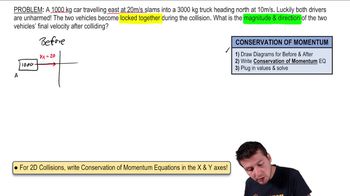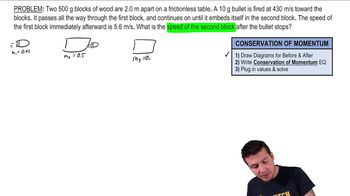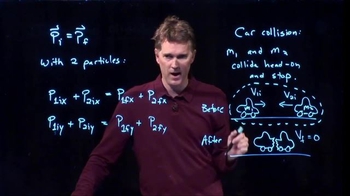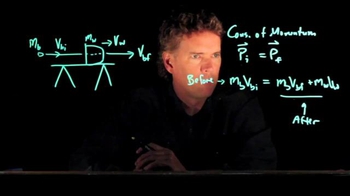11. Momentum & Impulse
Completely Inelastic Collisions
Learn with other creators
Practice this topic
- Multiple Choice
A 70-kg hockey player skates on frictionless ice at 5m/s. An opposing player of mass 110kg collides head-on with him at 4m/s. The two players become entangled after the collision and move together. Determine their final velocity.
1209views40rank1comments - Multiple ChoiceA1500 kgtruck movingslams into a stationary300 kgcar. The two stick together. How fast are they moving immediately after the collision?826views
- Multiple ChoiceA200 gblob of clay is moving in the positive y-direction at. A500 gblob of clay is moving in the positive x-direction at. They collide and stick. What is the speed and direction of the resulting blob of clay? Give your answer as an angle counterclockwise from the positive x-axis.871views
- Multiple ChoiceAn explosive projectile is flying through the air horizontally at a speed of , when it explodes into two fragments, one twice as heavy as the other. The heavier fragment falls straight downward. What is the speed of the lighter fragment just after the explosion?727views
- Textbook Question
To protect their young in the nest, peregrine falcons will fly into birds of prey (such as ravens) at high speed. In one such episode, a 600-g falcon flying at 20.0 m/s hit a 1.50-kg raven flying at 9.0 m/s. The falcon hit the raven at right angles to its original path and bounced back at 5.0 m/s. (These figures were estimated by the author as he watched this attack occur in northern New Mexico.) What was the raven's speed right after the collision?
1340views - Textbook Question
To protect their young in the nest, peregrine falcons will fly into birds of prey (such as ravens) at high speed. In one such episode, a 600-g falcon flying at 20.0 m/s hit a 1.50-kg raven flying at 9.0 m/s. The falcon hit the raven at right angles to its original path and bounced back at 5.0 m/s. (These figures were estimated by the author as he watched this attack occur in northern New Mexico.) By what angle did the falcon change the raven's direction of motion?
4286views - Textbook Question
Jack (mass 55.0 kg) is sliding due east with speed 8.00 m/s on the surface of a frozen pond. He collides with Jill (mass 48.0 kg), who is initially at rest. After the collision, Jack is traveling at 5.00 m/s in a direction 34.0° north of east. What is Jill's velocity (magnitude and direction) after the collision? Ignore friction.
2153views1comments - Textbook Question
Two ice skaters, Daniel (mass 65.0 kg) and Rebecca (mass 45.0 kg), are practicing. Daniel stops to tie his shoelace and, while at rest, is struck by Rebecca, who is moving at 13.0 m/s before she collides with him. After the collision, Rebecca has a velocity of magnitude 8.00 m/s at an angle of 53.1° from her initial direction. Both skaters move on the frictionless, horizontal surface of the rink. What is the change in total kinetic energy of the two skaters as a result of the collision?
703views

















